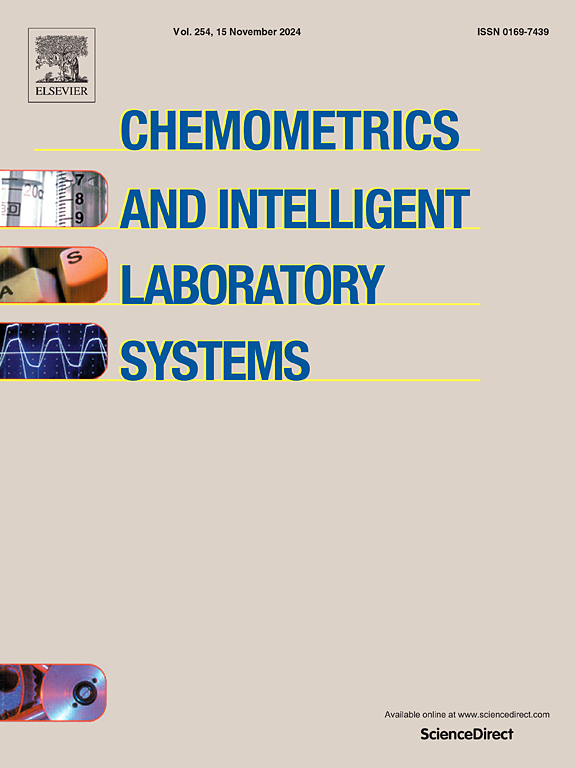Transfer contrastive learning for Raman spectra data of urine: Detection of glucose, protein, and prediction of kidney disorders
IF 3.8
2区 化学
Q2 AUTOMATION & CONTROL SYSTEMS
Chemometrics and Intelligent Laboratory Systems
Pub Date : 2025-03-27
DOI:10.1016/j.chemolab.2025.105384
引用次数: 0
Abstract
Raman spectroscopy, a non-invasive analytical technique, reveals significant potential in clinical diagnosis of kidney disorders by detecting key biomolecules in urine samples, especially glucose and protein. Although machine learning models have been widely applied for efficiently analyzing Raman spectral data, the high-dimensionality, imbalance and sample-scarcity of Raman spectral data still pose challenges to the models in achieving accurate detection. To address these challenges, we propose a novel deep learning model, TCRaman, which integrates transfer learning and contrastive learning for urine detection using Raman spectral data. As contrastive learning is capable of representation learning on imbalanced data, TCRaman first utilizes a pretrained contrastive learning model on a large labeled Raman spectral dataset of bacteria, to enhance the model’s capability to learn meaningful low-dimensional representations from high-dimensional Raman spectral data. Then, the pretrained model is finetuned on clinical urine Raman spectral data. This transfer learning framework is a foundation model that can break through the limitation of sample-scarcity on different downstream tasks. The experiments demonstrate the superiority of TCRaman compared with current state-of-the-art models. The results show that TCRaman achieves 91% accuracy on the detection of both glucose and protein, and 95% accuracy on the prediction of kidney disorders, highlighting the effectiveness of our proposed method in detecting urine Raman spectra. The proposed TCRaman method provides a promising way for accurate, rapid, and cost-effective detection for spectral data of biochemical samples.

尿液拉曼光谱数据的迁移对比学习:葡萄糖、蛋白质的检测和肾脏疾病的预测
拉曼光谱是一种无创分析技术,通过检测尿液样本中的关键生物分子,特别是葡萄糖和蛋白质,在肾脏疾病的临床诊断中显示出巨大的潜力。尽管机器学习模型已被广泛应用于拉曼光谱数据的高效分析,但拉曼光谱数据的高维性、不平衡性和样本稀缺性仍然给模型实现准确检测带来挑战。为了解决这些挑战,我们提出了一种新的深度学习模型,TCRaman,它集成了迁移学习和对比学习,用于使用拉曼光谱数据进行尿液检测。由于对比学习能够对不平衡数据进行表征学习,TCRaman首先在细菌的大型标记拉曼光谱数据集上使用预训练的对比学习模型,以增强模型从高维拉曼光谱数据中学习有意义的低维表征的能力。然后,根据临床尿液拉曼光谱数据对预训练模型进行微调。该迁移学习框架是突破下游不同任务样本稀缺性限制的基础模型。实验表明,与目前最先进的模型相比,TCRaman具有优越性。结果表明,TCRaman在检测葡萄糖和蛋白质方面达到91%的准确率,在预测肾脏疾病方面达到95%的准确率,突出了我们提出的方法在检测尿液拉曼光谱方面的有效性。提出的TCRaman方法为生化样品光谱数据的准确、快速、经济有效的检测提供了一种有前途的方法。
本文章由计算机程序翻译,如有差异,请以英文原文为准。
求助全文
约1分钟内获得全文
求助全文
来源期刊
CiteScore
7.50
自引率
7.70%
发文量
169
审稿时长
3.4 months
期刊介绍:
Chemometrics and Intelligent Laboratory Systems publishes original research papers, short communications, reviews, tutorials and Original Software Publications reporting on development of novel statistical, mathematical, or computer techniques in Chemistry and related disciplines.
Chemometrics is the chemical discipline that uses mathematical and statistical methods to design or select optimal procedures and experiments, and to provide maximum chemical information by analysing chemical data.
The journal deals with the following topics:
1) Development of new statistical, mathematical and chemometrical methods for Chemistry and related fields (Environmental Chemistry, Biochemistry, Toxicology, System Biology, -Omics, etc.)
2) Novel applications of chemometrics to all branches of Chemistry and related fields (typical domains of interest are: process data analysis, experimental design, data mining, signal processing, supervised modelling, decision making, robust statistics, mixture analysis, multivariate calibration etc.) Routine applications of established chemometrical techniques will not be considered.
3) Development of new software that provides novel tools or truly advances the use of chemometrical methods.
4) Well characterized data sets to test performance for the new methods and software.
The journal complies with International Committee of Medical Journal Editors'' Uniform requirements for manuscripts.

 求助内容:
求助内容: 应助结果提醒方式:
应助结果提醒方式:


